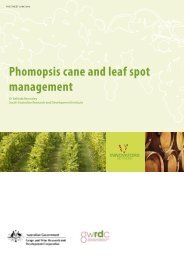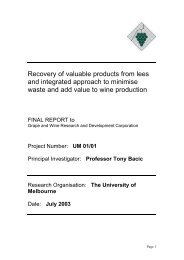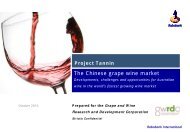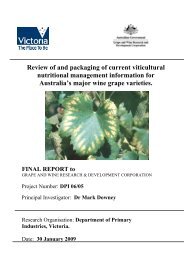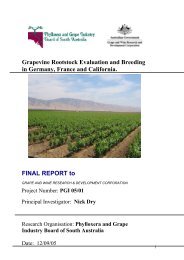Identification of the major drivers of 'phenolic' taste in ... - GWRDC
Identification of the major drivers of 'phenolic' taste in ... - GWRDC
Identification of the major drivers of 'phenolic' taste in ... - GWRDC
You also want an ePaper? Increase the reach of your titles
YUMPU automatically turns print PDFs into web optimized ePapers that Google loves.
AWRI: <strong>Identification</strong> Of The Major Drivers Of ‘Phenolic’ Taste In White W<strong>in</strong>es<br />
<strong>the</strong>y called ‘phenolic hotness’ that <strong>the</strong>y described as be<strong>in</strong>g a burn<strong>in</strong>g sensation at <strong>the</strong> back <strong>of</strong> <strong>the</strong><br />
throat that was unrelated to <strong>the</strong> whole mouth sensation <strong>of</strong> alcohol warmth. Informal tast<strong>in</strong>gs <strong>of</strong><br />
phenolic w<strong>in</strong>es stripped <strong>of</strong> most <strong>of</strong> <strong>the</strong>ir alcohol under vacuum by an experienced panel supported <strong>the</strong><br />
existence <strong>of</strong> a back <strong>of</strong> <strong>the</strong> throat burn<strong>in</strong>g sensation. In <strong>the</strong> absence <strong>of</strong> a known chemical standard for<br />
this attribute, a fresh Australian extra virg<strong>in</strong> olive oil that was described by judges at <strong>the</strong> 2010<br />
Australian National Extra Virg<strong>in</strong> Olive Oil Show as be<strong>in</strong>g pungent was presented as a tra<strong>in</strong><strong>in</strong>g<br />
example. Pungency is an <strong>of</strong>ficially recognised term used by olive oil assessors to describe <strong>the</strong> throat<br />
burn<strong>in</strong>g sensation elicited by <strong>the</strong> olive oil phenolic oleocanthal. The sensation was thought to be a<br />
good proxy to illustrate a burn<strong>in</strong>g character as it was <strong>of</strong> known phenolic orig<strong>in</strong>. Aqueous solutions <strong>of</strong><br />
0.5 g/L alum<strong>in</strong>ium potassium sulfate, qu<strong>in</strong><strong>in</strong>e sulfate (15 mg/L) and carboxymethycellulose (3 g/L)<br />
were also presented to demonstrate astr<strong>in</strong>gency, bitterness and viscosity respectively.<br />
Two or three examples <strong>of</strong> model w<strong>in</strong>es (pH 3.5, 10% v/v alcohol) conta<strong>in</strong><strong>in</strong>g ei<strong>the</strong>r high (60 mg/L) or<br />
low (30 mg/L) concentrations <strong>of</strong> Grape reaction product (GRP) and caftaric acid or <strong>the</strong>ir mixtures,<br />
were presented over <strong>the</strong> follow<strong>in</strong>g three tra<strong>in</strong><strong>in</strong>g sessions <strong>in</strong> order to generate and def<strong>in</strong>e <strong>taste</strong> and<br />
texture attributes associated with <strong>the</strong> samples. The f<strong>in</strong>al two tra<strong>in</strong><strong>in</strong>g sessions were used to familiarise<br />
<strong>the</strong> <strong>taste</strong>rs with <strong>the</strong> use <strong>of</strong> <strong>the</strong> 15 cm partially structured tast<strong>in</strong>g scale and to identify any attribute<br />
redundancies. Four samples (model w<strong>in</strong>e, high and low GRP and high caftaric acid) were presented <strong>in</strong><br />
duplicate over consecutive days for this purpose.<br />
7.2.4 Formal Assessment<br />
The test samples were assessed <strong>in</strong> triplicate. The fifteen test samples were presented over three<br />
sessions <strong>in</strong> a randomised order. 40 mL <strong>of</strong> sample was presented <strong>in</strong> black tast<strong>in</strong>g glasses at room<br />
temperature (23°C ±1°C). A two m<strong>in</strong>ute rest was enforced between samples, and an additional eight<br />
m<strong>in</strong>ute rest was enforced after <strong>the</strong> third sample. The list <strong>of</strong> selected attributes and <strong>the</strong>ir def<strong>in</strong>itions are<br />
provided <strong>in</strong> Appendix B, Table B-3. The <strong>in</strong>tensity <strong>of</strong> <strong>the</strong>se was assessed us<strong>in</strong>g <strong>the</strong> 15 cm partially<br />
structured l<strong>in</strong>e scale described previously.<br />
7.2.5 Statistical Analysis<br />
Where zero rat<strong>in</strong>gs for a particular attribute were given to all samples on all tast<strong>in</strong>g occasions by an<br />
assessor, <strong>the</strong>ir rat<strong>in</strong>gs were excluded from analysis as <strong>the</strong>y were considered ei<strong>the</strong>r <strong>in</strong>sensitive to <strong>the</strong><br />
attribute or did not understand it. The rat<strong>in</strong>gs from one assessor were excluded for both <strong>the</strong><br />
‘astr<strong>in</strong>gency’ and ‘metallic’ attributes, two were excluded for ‘oil<strong>in</strong>ess’, and three for <strong>the</strong> ‘prickly’<br />
character. The rat<strong>in</strong>gs from at least eight assessors rema<strong>in</strong>ed for each attribute which is considered<br />
acceptable for descriptive analysis. Assessor consistency across tast<strong>in</strong>g sessions was assessed us<strong>in</strong>g<br />
Kendall’s coefficient <strong>of</strong> concordance (Siegel 1956). A three way analysis <strong>of</strong> variance <strong>of</strong> each tast<strong>in</strong>g<br />
attribute was conducted with assessors, caftaric acid concentration and GRP concentration as<br />
treatment effects, with assessors be<strong>in</strong>g treated as random effects. Means separation was conducted<br />
us<strong>in</strong>g Fishers Least Significant Difference. The relationship between attributes was also <strong>in</strong>vestigated<br />
us<strong>in</strong>g Pearson’s correlation coefficients.<br />
57




